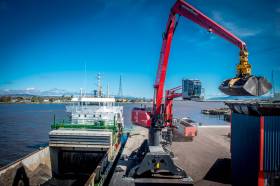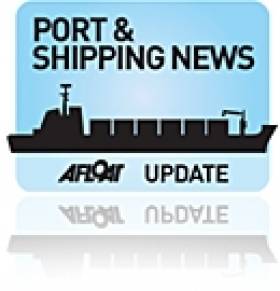Displaying items by tag: Record Profits
Europe's Largest Short-Sea Operator Wilson Says No Newbuilds on Horizon as It Posts Record Profits
Norwegian based small-bulker shipping giant Wilson ASA of Bergen has turned in a booming second quarter result with its fleet of over 100 owned vessels under 8,500 dwt.
The Oslo-listed owner and operator is keen to use some of the money on fleet renewal in the form of secondhand purchases, but no newbuildings are on the horizon, chief financial officer Stig Vangen.
“Last year was already a very good year and this year we are already almost at the same result level of full-year 2021,” he said to TradeWinds which has more here.
Afloat adds that on an annual basis, Europe's largest short-sea operator, Wilson ASA transport about 15 million tonnes dry cargo throughout the continent and with approximately 10,000 port calls a year.
As a fully integrated shipping company, they handle in house: chartering and operations, ship management, marine accounting, crewing, purchasing, legal and insurance. This involves employing about 2,000 staff employees with a head office in Bergen and branch offices strategically located in Europe.
Their blue-hulled cargoships ranging from 1,500-8,500dwt commonly trade in Irish waters. Among them Wilson Blyth (3,713dwt) which in 2015 made a most unusual call to Dun Laoghaire Harbour to enable a project cargo bound for the Guinness St. James Gate Brewery in Dublin.
The Wilson Blyth which recently sailed to Dublin Port from Rouen, France, has departed the capital's port this afternoon bound for El Ferrol, Spain.
Afloat has also identified another example of their extensive fleet operating in Irish waters, the Cork Wilson (4,450dwt) as pictured above aptly at the ship's namesake port city when berthed at the South Quays nearby to the former R&H Hall silo.
The 1998 built cargoship at just shy of 100m length overall, also features on the front cover of the Wilson quarterly report (download in Norwegian), with the vessel seen on the same occasion during the call to the Port of Cork.
Further research reveals that other Irish Ports form the ship names of the following cargoships; Wilson Dunmore, Wilson Dundalk, Wilson Dublin and Wilson Drogheda respectively. In addition they are all of the 3,000dwt plus category.
A Dubai-based owner of P&O Ferries has reported record-breaking profits just months after sacking 800 of its UK-based workers without notice.
DP World, which is ultimately owned by the Dubai royal family, said in March that firing 786 P&O seafarers and replacing them with much cheaper agency workers was the only way to ensure the “future viability” of the historic ferry business.
However, on Thursday Sultan Ahmed bin Sulayem, DP World’s chair and chief executive, announced the company had increased its first-half revenues by 60 per cent to $7.9 billion (€7.8bn) and profits had risen by more than 50 per cent to a record $721 million.
“We are delighted to report a record set of first-half results with … attributable earnings [profits] rising 51.8 per cent,” he said in the company’s earning’s statement on Thursday. “Overall the strong first-half performance leaves us well placed to deliver improved full-year results.”
Further coverage The Irish Times has on the seafarers sackings which included those working on the Irish Sea.
Another Record As Shannon Foynes Port Company Delivers Profit Levels
It was another record performance achieved at Shannon Foynes Port Company (SFPC) as the western port revealed its annual report for 2018.
According to SFPC, earnings before interest, tax, depreciation and amortisation (EBITDA) were €6.8million. As for operating profits in the period they remained exceptionally strong at €4.8million, €1.2million or 34% higher than five years ago, 2014. Revenue increased by 4.9%.
The company’s main ports on the Shannon Estuary, Foynes and Limerick, again achieved record tonnage levels, with an 11.7% increase in throughput. However, overall tonnage throughput was down by 5.5% to 10.7million due to a reduction of activity at privately managed terminals on the estuary.
This is the sixth year in succession that general cargo terminals have increased year on year.
Tonnages at Foynes and Limerick terminals for 2018 are some 50% higher at end 2018 than at end 2013 and exceed previous historically high tonnage levels experienced during 2006 by 11.2%.
To read more click the download here.
Strongest Financial Results in Foyle Ports' 162-Year History
#ports&shipping - A record-breaking 50% rise in profits has been announced by Foyle Ports and the news has led to the company's "strongest financial performance" in its 162-year history.
The Irish News reports that the Derry port reported its fifth year of consecutive growth at its Annual General Meeting, with record operating profit of £2.2million generated from a turnover of £8.6 million for the 2016/2017 period.
As documented previously the port re-invests all its profits to improve the business and upgrade facilities and last year capital investment totalled £3.6 million. This included state of the art tug boat to safeguard the future shipping operations in Lough Foyle. To date over £30million has been re-invested as part of the long-term capital expenditure programme.
For further reading on the financial performance of the north-west port, click here.
Record Profits at Shannon Foynes Port Company
#SFPCrecordProfit – Record profits at Shannon Foynes Port Company were announced in their annual report for 2013, which revealed record operating and gross profits.
SFPC is Ireland's second largest bulk port company and operates six ports on the Shannon Estuary, including Limerick Port.
This is the company's fourth successive year in achieving record operating profits, showing a 35 percent increase in Operating Profit at €4.1m, up from €3.1m in 2012.
The Limerick Leader has more on this to report, by clicking HERE.































































